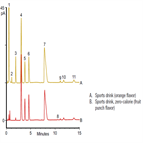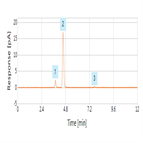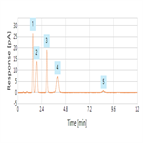Find methods for your needs
Refine by Feature
Displaying 1-5 of 9 results for Tag: Acclaim Trinity P2
API and counterions in Adderall using multi-mode liquid chromatography with charged aerosol detection
Instrument Type: HPLC-CADThis work demonstrates the determination of the API (amphetamine) and counterions (aspartate, saccharin and sulfate) in a medicine Adderall within a single analysis using a Thermo Scientific Acclaim Trinity P2 column and Thermo Scientific Dionex Corona Veo Charged Aerosol Detector (CAD).
Determination of electrolytes in sports beverages by HPLC-CAD
Instrument Type: HPLC-CADThe Thermo Scientific Dionex UltiMate 3000 RS system is applied for the analysis of electrolytes in sports beverages. The separation is performed on a Thermo Scientific Acclaim Trinity P2 column, which is designed to resolve a broad range of anions and cations, mono- or multi-valent, in a single analysis using a simple gradient method. The Thermo Scientific OnGuard II P cartridge was used to remove artificial colors from the samples.
Determination of artificial sugars in cough drops using a simple HILIC method
Instrument Type: HPLC-CADThe Thermo Scientific Acclaim Trinity P2 used in HILIC mode separated malitol and isomalt in cough drops using a simple HILIC method.
Analysis of sugars in HILIC Mode
Instrument Type: HPLC-CADThe Thermo Scientific Acclaim Trinity P2 provides HILIC interactions in addition to anion-exchange and cation-exchange properties. It is shown here that both monosaccharides (fructose and glucose) and disaccharides (sucrose and lactose) can be sufficiently retained and separated on a 50 mm long column in 80% acetonitrile at 60 °C.
Determination of guanidine in phosphate buffered saline
Instrument Type: HPLC-CADThe Thermo Scientific Acclaim Trinity P2 column was used to determine a small amount of guanidine in a background of phosphate buffered saline (PBS). Even though the high concentration of sodium chloride overloads the column, it has sufficient resolution for quantifying all the components.





